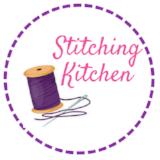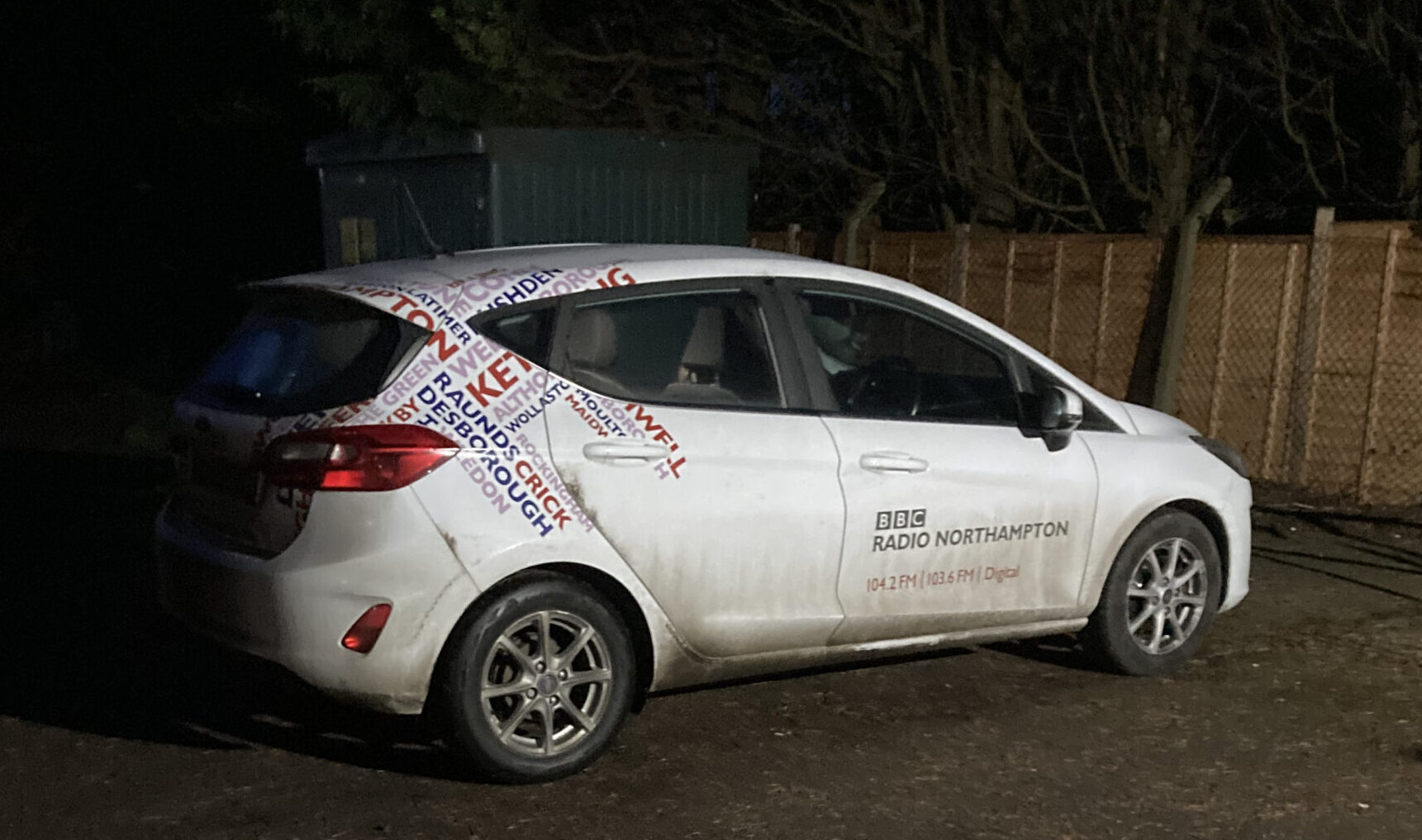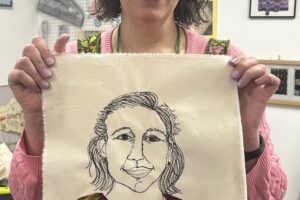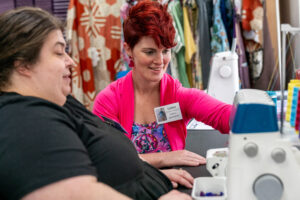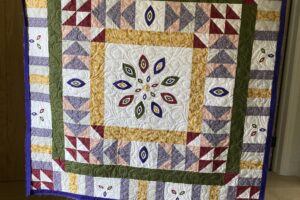When Radio Northampton visited Stitching Kitchen for Breakfast!
A few weeks ago BBC Radio Northampton joined us at Stitching Kitchen for Breakfast – in case you missed listening to the interviews live or the replay on BBC Sounds here is a transcript of our interviews….
Toms First Impressions:
Annabelle: Now, Brackley is where you have made your way to this morning. It’s something called the Stitching Kitchen. So tell us a bit about that.
Tom: It is I mean, first of all, it’s one of the most colourful places I’ve been with work. I kind of mauve white polka dotted rubberized tablecloths, a top kitchen tables dotted throughout a room where I’m surrounded on all sides by it looks like a haberdashery to be perfectly honest, vivid colours. There’s a shirt on a mannequin over there. ‘Be like the sundial” an enormous patchwork wall hanging on the wall over there. This is the domain… I suppose it’s kind it’s well it’s a classroom. It’s a social club. It’s all sorts and it’s run by Hannah Thompson, who you had on desert island dishes last week when we were in Brackley for that we wanted to come meet her meet some of our customers and because you know hey, I am a demon with a needle and thread and so we are going to get me making something this morning. In Brackley at the Stitching Kitchen. Lovely!
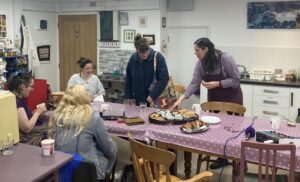
Hannahs Interview:
Annabelle: It is 7:24 now and we cross to Tom for his live interview visiting Brackley this morning and you are crafting?
Tom: Yes, I am. Because when we went to Brackley, for desert island dishes, we spoke to a lovely lady named Hannah Thompson about her business, the Stitching Kitchen and I was driving back from wherever I was that morning. I thought, hey, this sounds nice. I should go and spend the morning with her. I can be creative. I’m open minded. Maybe I might learn a thing or two. And so here I am in Brackley at the Stitching Kitchen at Top Station Road on the outskirts of Brackley and it is warm and friendly and welcoming. You’ve got kitchen tables with those kinds of waterproof tablecloths that you might put down when your child’s doing some painting, they’ve got those on top. A sofa in the corner, things in various stages of being made; a shirt, a scarf, various bits of cross stitch – all sorts. Throughout the week there are classes here and it’s not just about learning something new, it’s about making friends. So we will be sitting around the table this morning and I might be learning something with Hannah.
When you walk in somewhere you get an instant vibe about somewhere. It’s like when you house hunt, you sort of know immediately if it’s going to be right. I walked through the front door this morning and I instantly felt happy and bright and welcomed.
Hannah: Yes, that was that was kind of the plan and it’s been quite a challenge because I set the business up at home it was in the kitchen at home so I had some of my textile art on the walls. And obviously I had to clean the family detritus away in order to teach people how to sew and make felt and things. So when I came into a big square white box, it was a bit of a challenge. So the first thing I did was get some paint out and paint some old furniture so it’s all in pinks, purples, that sort of thing. And then my kids said yes we can print using Indian Blocks we can print the blind fabric. So even the blinds have been hand printed. So they are they each letter individually printed on there. Wow. And so they’re all words related to the business. So it’s things like needles, Stitching Kitchen and thread and there are spelling mistakes. And there are upside down letters so you can see it’s genuine. I can see rag rug in there. And the other thing that will be in amongst all those words is tea and cake because both of those things are very important.
Tom: Essential fuel of the Crafter. Absolutely. Your love of crafting began when?
Hannah: Well, I think if it’s something that you grew up with if you’re really lucky. So my mum and my grandma used to keep us amused when we weren’t feral outside building dens in the hedges. We were around the kitchen table making things so I think I knitted a jumper when I was about 10. I then discovered that sewing is a lot quicker – so that was good. And then I hadn’t touched it at all all the way through adult life; I think had made one beanbag and two pairs of curtains in the you know, the next 20 years or so. And then I got divorced and I had a big void. And I had all this time on my hands when my children weren’t with me, and a friend dragged me along to Embroiderers Guild, and I haven’t looked back since. I’ve been making for the last eight years constantly.
Tom: And this is something about kind of for people for whom it’s a real passion reaching back into their past and the memory and the feeling of doing it as a child or is it just about the process and some of the kind of mindfulness because we’re told if you indulge in a repetitive activity that benefits you.
Hannah: Absolutely. I’d say there’s quite a mix with me because I do like to use recycled and reclaimed materials. So if you look to the side, there’s a seascape up on the wall. And in amongst that is actually things that are relevant to the sea side. So there’s actually a bikini in there, you wouldn’t believe it. And whilst I was making it, I lost a pair of earrings. So there’s one of the earrings in it somewhere. So there are things that are memories. Theres limpet shells from the beach, we went to that summer. Then there’s also the process of making and when I was going through a really tough time with my mental health; every time I went to a doctor surgery I had my embroidery with me, and it took me weeks. But all of those colours all of those stitches, each one just gently calms the mind and helps you get through those difficult times. And then you meet other people that have been on the same journey and I think that’s the important thing. Life’s not always easy. And stitching sometimes helps.
Tom: I guess, you know, you now have a business where people can come together and learn new skills, but I’m guessing always the bigger part of it for people is just sitting around a table and sharing some of those stories.
Hannah: Absolutely. And it can be as light hearted as yesterday evening we had a crochet class here. And they were three ladies that knew each other through their village. Coincidentally, they knew the crochet teacher because she used to teach in their local school and they were all chatting about whatever was going on. But there was another lady there from a different area and she felt included and they were talking about yes, their love of bright colours but also their their lives and what was going on. And then they had a couple of cups of tea and a piece of cake as well. So they had a lovely evening and I’ve had lots of messages overnight saying thank you so much. We’ve had so much fun.
Tom: It must be great. Time is short, but briefly what are you going to have me doing?
Hannah: Okay, I’m beginning to regret this because we’ve been talking so much, but I’d like you to make a felt glasses case. So we start off with the fluffy wool that’s come off a sheep and we end up with a three dimensional glasses case. Not still bleeting is it? no no no, it’s okay. It’s been Shawn it’s all perfectly OK
Tom: signed up for great okay, well, I mean, you’ve got an uphill battle because I’m possibly the least able least creative person worst with my hands you’ve ever seen. But good luck. Thanks very much. Thank you. Hannah Thompson from the Stitching Kitchen. We’ll be back here later.
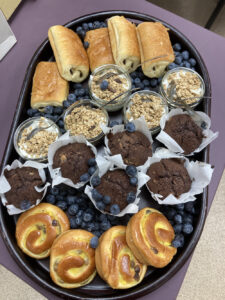
Lindseys Interview:
Tom: Welcome back to Brackley and to Stitching Kitchen where Hannah Thompson can teach you all manner of crafting skills in a friendly environment. You could come here learn something new, make friends have a great time. We got to hear about it when she was on desert island dishes last week. So I wanted to come along. And earlier she’s had to head to work now. But we met someone who comes here to teach use of something called an overlocker ever heard of one I hadn’t. Lindsey Webster will explain life and craft
Lindsey: I have craft as long as I can remember, Mum she has her hand in every craft you can think of and one of our kind of challenges now it’s become is to get her a new crafting gift every year for her birthday and it’s getting a bit obscure.
Tom: what’s the strangest thing you’ve had your mom go to?
Lindsey: the oddest thing we did some needle felting last year we made little birds. actually how I discovered Hannah and Stitching Kitchen is because we were trying to find a new craft from a mum and we found the wet felting around a resist which is where you make a little bowl which every time my nephew goes to my mom’s house now is his new favourite thing. Oh, this little bowl.
Tom: and how much those about new experiences for your mum and how much of it is just about I guess the two of us sharing something or kind of having quality time with a parent because as you reach out on it yourself that that changes a bit.
Lindsey: I think it’s something that because we’ve always done, its the drive to keep doing it. I missed my mom a lot during lockdown when we couldn’t see each other especially because she had just move to the same town. So someone’s closer it makes it harder absolutely she’s right there and I can’t see you. So kind of that’s what accelerated my love of sewing actually, is because I wanted to make a shirt and previously I would have gone to my mom and we would have done it together and she would have helped me out. I say helped me out she would have done most of it. And I would have made the tea – very vital part of the crafting process. But all of a sudden she wasn’t there. So I had to do it myself. If I wanted to do it. I had to do it myself.
Tom: So I did what were your first impressions when you walked in here?
Lindsey: This is awesome. This is home. Yeah, so I came in. She had everything set up all the all the yarns I want to do the felting and everything. And I was oh what’s upstairs? Took a little sneak peek upstairs and all the sewing machines are set up there and there’s a huge sewing space cutting tables, every thread colour you can imagine. And I came back down and I said you know if you if you need a stretch fabric specialist Hi. Hi, I’m your girl because I’ve been doing stretch fabric sewing more because that’s what I want to wear. This fabric that conforms to me that I can move in I do a lot of aerial acrobatic stuff silk poles, aerial hoop, that sort of thing so that the clothing needs to move with you. So that’s what I want to wear and during lockdown I bought an overlocker for 40 quid and a houseplant from a friend of mine.
Tom: So I need to ask what’s an overlocker? I’m thinking that’s what I put my bag in at the swimming pool.
Lindsey: So it’s you’ll see it a lot on commercial garments. It’s a machine that does four thread stitching. So there’s two lines of stitching that hold the garment together and then two Looper stitches which go around the raw edges of the fabric. So the structure of the stitch itself is stretchy.
Tom: So is this like kind of the inside seam on a pair of jeans?
Lindsey: Yeah, exactly. So wherever you see kind of more threads than you you would know what to do with that’s that’s an overlocker and the seam itself stretches so essential for things like leggings, which is a workshop that I teach here, T shirts, anything that stretches that needs to stretch with your body, you’re going to need a stretch stitch. It is not essential for sewing stretch, you can do it on a sewing machine, but it’s so much faster. I think my machine runs at 2000 stitches a minute.
Tom: Okay, that’ll do that’s pretty speedy.
Lindsey: Yeah.
Tom: Wow. When you get to share your expertise with someone who’s a novice, how does that feel?
Lindsey: Amazing. I love seeing the progression of someone’s skills. Coming in, completely lacking confidence are they’ve taken the machine out of the box that day and they’ve not looked at it since they bought it or it’s been handed down from someone and then going oh, I don’t know what to do. And developing that confidence as much as that skill. So the first thing I always do when I teach the overlocker courses, is get everybody to snip the threads off because threading and overlocker is this terrifying monster that people just are too scared to do. And you see everybody go home. But guiding them through, you know you you can do it. You just need to practice it a little bit. If you’ve done it do it again. And seeing that confidence in their own skill builders is awesome.
Tom: What are you working on at the moment for yourself?
Lindsey: Oh my gosh. So I sew for UK stretch fabrics a stretch fabric company which is where all this amazing vibrant fabric comes from
Tom: You are dressed in the most colourful I’ve ever seen my life
Lindsey: My aesthetic is kids TV presenter.
Tom: Do you know what? That’s absolutely fair and I can see absolutely teaching my daughter a song on CBeebies. So sure,
Lindsey: yeah, this is actually my it’s my outfit today’s a hand knitted bright blue jumper and a jumpsuit in kind of bright orange every colour ever all the colours. They’re all there, but this is actually quite muted for me.
Tom: Is it really?
Lindsey: This is a calm day. Yeah, so I love the bright colours and having that freedom to make something that suits your personality is also my dress more like me now than I ever have done in my life. Even stuff like I couldn’t wear a jumpsuit before I’m five foot tall. the crotch of a jumpsuit would be at my knees. They just don’t fit for just like Exactly. Now that I can make them myself. They fit perfectly and they have maybe 15 in my wardrobe.
Tom: And that is the most muted of them. That’s the Yeah, yeah. Wow. It’s really good to meet you. I love that. You just kind of beams out of you. You’ll love this stuff. It’s great. Good to see. Thank you. Well, now we know it overlocker I mean it wouldn’t be able to work one but we know what one is? Well exactly. If you own jeans or leggings or anything that stretches at the seams then it is stitched using an overlocker There you go. Lindsey teaches it. We’ll be back here at Stitching Kitchen where I am making you, Annabelle, a felt case for your new reading specs!
Vees interview:
Tom: And so at the Stitching Kitchen, you can come and learn new stuff and make new friends. Sounds pretty perfect, doesn’t it? Let’s have a chat with someone else who comes down here. That’s Vee Griffith – first of all 10 out of 10 because you are wearing a top that precisely matches the purple of our microphone windshield. Well done. Thank you. It’s like you planned ahead no one else no one else reads the brief. Where did your love of crafting begin?
Vee: I always remember crafting. It was something again that I did with my mum. And I’ve done it throughout my life, on and off. But whenever I’ve had the time and also whenever I’ve been shorter cash because you can make things that are so much better than you can afford.
Tom: Yeah. Which is lovely, isn’t it? I suppose. And and so I guess Can you describe for me the feeling or the glow that you get when you wear something that you’ve made and someone compliments you?
Vee: Oh, it’s wonderful. It really is it? It feels like validation. This took me 50 hours. I’m pleased you noticed. Yeah. I knit and I knit jumpers but a jumper takes me a year to knit. Not because it takes that long but because I get bored and wants to do other projects in between. Yeah, but I’ve never finished a jumper in less than a year. It feels someone says your jumper looks really nice. It’s beautiful. But it took me all of 2022 to knit.
Tom: your jumpers are almost like tree rings. Okay, this 2022 edition. This is what 2023 What’s your work? You’re working on paper? At the moment?
Vee: Yes. I’m embroidering on to my handmade paper.
Tom: So how do you make paper by hand?
Vee: Well, I recycled most of my crafts are recycled and I take scraps of paper. I like the coloured papers. So I will pick out the coloured papers that come through my door my junk mail, mash them all up. Put them on a nice flat screen something porous. Yeah. And flattened out. Basically you put a lot of water in flight and you
Tom: Yes, almost like I was about to use an analogy that I’m not going to use, really? But it’s always that he goes kind of jellified doesn’t it you spread this slurry out on the on the screen and then just put some weights on it and wait.
Vee: You don’t have to put weights on it. It will drain Yeah. And then afterwards. After it’s drained a bit you can turn it out onto. I use paper handkerchiefs because they got nice fine weave and it doesn’t affect the smoothness of the paper too much. I turn it out onto paper and chips and put books on the top to flatten it and a couple of days later, I got a nice clean sheet of paper.
Tom: Some people listening to this might think I can see the point of knitting a jumper or something like that. But why would you want to make your own paper you can just go and get a sheet of it from the drawer and draw on it.
Vee: I can but the paper that I’m working on at the moment is full of flower petals and little inclusions. You never get anything as unique as your handmade sheet of paper. It’s It’s glorious. I love doing it.
Tom: When you see the look on your face. There’s always like this look of Wonder process and what you create. What does it mean to you that you find a group of like minded people like we have here to do it with and to share it with?
Vee: Oh, it’s amazing. It’s such a wonderful community of people. And you can come and if you’re having a bad day, they just lift your spirits up.
Tom: Is that more is that more important almost than the process or the thing you’re doing?
Vee: Yes, definitely. It’s like having a bunch of friends. And every now and again you get to make a new friend which is wonderful.
Tom: Hannah, who is sitting there with this kind of slightly misty eyed look?
Hannah: Yes, it’s lovely and actually Vee has. She’s had some tough times and some really difficult times over the I mean, I’ve known Vee since I started the business in 2017. So we’ve both been through some real ups and downs. And she’s come up with some pearls of wisdom for me and vice versa and it’s been brilliant because the has come out of her shell she’s now she teaches knitting for me every month. And she’s also just starting a Tuesday evening craft along kind of thing where people can just rock up and do a different craft every week. This woman is a craft machine. She has so many ideas. It’s amazing.
Tom: So you’re. just sitting there it with one arm slung over the back of the chair. They’re just like just just as laid back not even fazed by any of this, but it’s always like when Yoda walks in and it’s like it’s like, like big person fundamental stuff.
Vee: No, no, definitely not. All right. I’m a jack of all trades. I’ve not a master of pretty much anything except knitting.
Tom: I think most people probably would disagree with that, wouldn’t they? It’s a pleasure to meet you. What would what is the thing if you if you look back on stuff that you’ve made, is there something that you can kind of hang your hat on and say that’s the thing that I’m proudest of?
Vee: The paper? Definitely
Tom: really what you’re doing at the moment. Where will you use it? Once it’s once you’ve finished?
Vee: Once I’ve finished a piece it goes in a frame and hang on the wall. It’s it’s a little piece of art
Tom: and it’s your home covered in this stuff.
Vee: There are a few up there yeah.
Tom: Very very diplomatically put well done.
Vee: I use them as memories of my holidays and things like that. So we’re it’s it I keep them as as mementos. Like people will keep photo albums
Tom: well like Hannah said you know with the with her seascape up there it’s got shells and things collected from a beach on a certain holiday achieved the same thing I suppose.
Angies Interview:
Tom: Exactly Annabelle and sharing I guess, the love of the friendship that comes from a shared interest and the joy of just practising that in company. That’s the whole point Stitching Kitchen. You walk in, and there are big kitchen tables and you gather around them. And one of you might be doing some needlepoint one might be doing some crochet or might be doing some knitting whatever it might be Vee, who we met earlier, was making paper whatever it is, you just sit doing your thing having a bit of a chat, what’s not to love? Well, while we’re here we did want to set me a bit of a challenge and you know that I’m not trusted around sharp objects at work Annabelle, so they set me a needle free task of making you a felt spectacles case. We’ll come on to how that’s going in a few minutes. But first, have you Annabelle ever been to one of those battle reenactments where you might see the sealed knot or people who think they’re Vikings or whatever bashing bashing each other over their heads. Have you ever been to one?
Annabelle: Oh those, been to plenty of those in my time on treasure quest.
Tom: Well, there you go. Would you like to hear from someone who makes their outfits? Well, yes, Angie Booth.
Angie: Hello.
Tom: Hello. How on earth did you get into that?
Angie: My parents. I’ve been doing it since I was about five.
Tom: It was slave labour!
Angie: Yeah, so I wasn’t making the costumes back then. But that’s how I got into reenacting because they did it.
Tom: Yes. What era?
Angie: 17th century; so you mentioned the sealed knot there. So we were in a rival group called the English Civil War society.
Tom: This has this has echoes of the Judean people’s front. Okay, good. And so what your childhood weekends were spent in tents at random country houses, watching people wallop each other with broadswords
Angie: Pretty much.
Tom: Wow, what was that? Like? I mean, I guess childhood is normal for each child, isn’t it?
Angie: Freedom! You know, my Mum and dad would sort of say you know, don’t get hurt and come back later kind of thing. But you also learn a lot about the history of the period and that just stuck with me. So when time moves on, I needed a hobby as an adult and I got my husband, my then husband into it as well. So we came back to it and that’s when I started sewing my own costumes.
Tom: And so what would a 17th century reenactment outfit consist of?
Angie: It can vary – so for a lady you’ve got a few skirts, and undergarment called a shift a corset and a bodice which would then go sort of your jacket if you like. And for a gentleman you would have hose like socks, pair of britches shirt and a jacket, but I kind of specialise in the Highland culture. So you would get people in kilts as well.
Tom: Wow. So when you’re making these outfits, I guess you got to do them for specific individuals, do you or do you just do small, medium and large?
Angie: But generally, it’s just for me and my husband. Occasionally I’ll do them for friends and I will make them to whatever size they are. But I’m going to be starting doing them a little bit more commercially. And they will be small, medium and large.
Tom: What do you get out of coming somewhere like Stitching Kitchen and I guess just sharing that passion with people?
Angie: It’s the friendship it’s as you’ve already said, it’s the friendship. I started coming to Stitching Kitchen I’ve moved to Brackley and lived here for a few years and I just wanted to make new friends and having the craft side it popped up on my Facebook feed and I just thought okay, let’s go and have a look and see what it’s all about and sort of been with Hannah since the beginning almost.
Tom: good. It can be nerve wracking, kinda when you walk through the door of a new place for the first time. What are your memories of that?
Angie: Just being very welcome. It was when Hannah had it in her kitchen. It was the actual kitchen. And yeah, I was nervous because I’m not great meeting new people, but I was made to feel very welcome and you soon forget about that because you’ve got a cup of coffee in front of you and you start chatting about what it is you’re sewing – it’s usually the first question you when you walk in.
Tom: What Civil War item of clothing you’re working on at the moment?
Angie: I’m actually making a shirt. Actually, it’s a highland shirt. So it’s a little bit longer than normal shirts, because it has to with the kilt and everything. I’m hand sewing, I don’t actually own a machine so overlocking and all that is a bit of a dark art for me. So everything I make is hand sewn.
Tom: I’m amazed impressed you’re far more talented person than I. Great to talk to you Angie Booth. There if you if you get into that Annabelle or if you want to, I don’t know rampage across Valhalla and your longboat, then I’ll hook you up with Angie. In the meantime, let’s speak with Hannah Thompson, the lady who started this all. We wanted to come and sample the vibe and it is a lovely vibe.
Hannah: Oh,thank you very much. Yeah, it’s just I just wanted to to everybody to experience what I had experienced when I was stitching alongside people. And just to build those friendships and to meet new people and to share ideas and sometimes sharing skills as well. And it’s it’s, yeah, it’s lovely. I’m really I’m feeling all proud.
Tom: You should do. Speaking of pride should I feel pride in what I’ve achieved so far with my felt spectacles case for Annabelle?
Hannah: Absolutely. I’d say you are a natural.
Tom: Natural Felter what stage are we at? What have I still got to do?
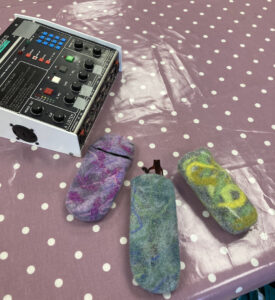
Hannah: Okay, so you have already laid down all the fibres. So you’ve put the groundwork in, you’ve done your decoration layer. We’ve now got to the point where the fibres are sticking together. So we’re at the pre felt stage. I’m afraid to say Tom that the next stage is the hard work. We need it to shrink by a third. So there’s some rocking and rolling and throwing to do.
Tom: sounds right up my street. Amazing. Where can people find you or find out about you?
Hannah: Oh, now this is a good question. So most people have found me via social media. So I’m all over things like the Facebook and the Instagram. We’ve just been talking about Twitter, which is a little bit fast for us craft people as I have to say, but I’ve also got the website so it’s stitchingkitchen.co.uk. You can book onto workshops there. There’s lots of information and there’s a contact me box. So if you have any questions, or the Stitching Kitchen is often open, so just drop in. I’m usually here every Thursday and Friday, and then other times too, so just pop in.
Tom: you’re on Top Station Road, aren’t you? So if you come into Brackley from the BP roundabout on the A 43 Then look out for the old station on your left as you go past the supermarket, head down the slope from there and there you are.
Hannah: That’s where we are. Yes. So it’s a little industrial state. And people think that Brackley has only got one industrial estate. This is the little one down at top station roads is the better one. Yeah, well, this is where the railway used to run through. Yeah, it’s lovely down here.
Tom: It’s been a pleasure to spend the morning with you thank you so much.
Hannah: Absolute pleasure Tom. It’s been great to have you here
Tom: thanks so much Hello Thompson from the Stitching Kitchen I need to get on with rolling my felt Annabelle so you’ll have to excuse me!
Tali and Camilla Interviews
Tali and Camilla were also interviewed by Tom but the interview was played back in the afternoon. Here is the transcript:
Presenter: Hannah Thompson from Brackley was on the breakfast show recently she was doing desert island dishes – Annabel’s brilliant feature. She was great fun, so our reporter Tom decided to go and spend the morning with her at Stitching Kitchen. Like a lot crafting business it started as a hobby and now is some where people go and enjoy it. And one of the more unusual members that Tom spoke to was someone called Camilla, Camilla Munton. She is recreating a panel from the Bayeux Tapestry. Remember from history you know, that picture with the geezer with the arrow in his eye! Camilla described what she is making.
Camilla: We have an image of a horse and rider with banners surrounded by a decorative panel.
Tom: so is this an actual bit of the Bayeux Tapestry or is it in the style of?
Camilla: So I am told It is an actual piece. Although I have not seen seen the actual tapestry!
Tom: you are missing a trick there.
Camilla: I know. I was really excited to go and see it, but when I got there the queue was really long. So I popped into the shop next door. I got chatting to a very lovely lady who creates these kits which are sections of tapestry, which are historically correct with all the threads, charts with the stitch guides.
Tom: So you are creating part of a tapestry. This is about the size of a couple of tea towels joined up together. How long have you been working on this?
Camilla: So the majority of the stitching and the focus has been mostly with Hannah, on Fridays.
Tom: okay. And I guess that leads us on to being here and how you got to hear about Stitching Kitchen.
Camilla: Yes. So I recently moved to the area, so I live in Bicester and wanted to find a social group that I could join, to get to know the area and to make some friends. And with a longstanding interest of crafts, I wanted to do more. I googled crafting clubs, and that was how I found Hannah’s Stitching Kitchen.
Tom: What were your first impressions when you walk through the door.
Camilla: Really friendly, welcoming. I was so nervous, coming to meet new people. And within 10 minutes I had a cup of coffee in my hand and I was chatting away and it felt like home ever since.
Tom: Also alongside Camilla is Tali Scott. Hello, Tali.
Tali: Hi there
Tom: was your experience the same as Camilla is that that instant friendliness?
Tali: Very much and there is always cake here.
Tom: Very nice.
Tali: Okay. I’ve been to a couple of sessions here. First one was getting to know your sewing machine. I actually had a very informal relationship and now I know it a little bit better.
Tom: But yet very welcoming, nice group.
Tali : And if you pitch up to beginning classes, you’re just at the stage that you’re more of the kind of the novice end of the spectrum where I am. Absolutely yes. The passion is there. I’d like to do a bit more but just been intimidated by I think growing up I’ve always resisted anything that was considered the girly things so did resistant materials would work and unfortunately did myself out of learning how to sew at the time. So now I’m learning later in life.
Tom: That’s interesting, because a lot of the people that we’ve met this morning have been people I mean, like Hannah, who were, I guess inducted into this stuff at a very young age and had this love of it from childhood and so when they come back to it as an adult to an extent you’re just kind of going back to what you knew already. But for you it is brand new.
Tali: Yes My mom makes clothes, but her sewing machine and overlocker absolutely do not touch do not change any settings! She sews beautifully!
Tom: like the stereo in your dad’s car when you’re a kid.
Tali: Absolutely yes Do not touch this. So it was kind of something that also I considered no I wouldn’t do that. And now actually, I’ve got two children and to be able to knock up a pair of leggings for them is quite handy.
Tom: And what do you get out of it now? Because I think when, you know, you’re good at something already it’s easy to get the pleasure from it. But when you’re trying to learn something new and you might be dropping stitches or making mistakes, I find that quite dispiriting is it quite hard to sort of, I don’t know sort of strap up a bit and get back in it.
Tali: Yes, I’ve definitely. Hannah is looking at me! I’ve definitely had moments of the McEnroe that you cannot be serious as I have finished a dress.
Tom: have you had meltdowns in here?
Tali: Semi yes it’s like just because you know in your head how and I think because we you know it’s not something we’re not familiar with. We’re all wearing clothes we know that they’ve been made we know it’s perfectly possible to make something look like that. And then when you can’t you go oh this is this is aggravating. But it’s practising so who knows!
Tom: Back to the Bayeux tapestry then so this has … there is writing, this is Harold on horseback, isn’t it? Where will it be finished? It looks pretty done to me.
Camilla: I did try and get it done for Christmas. And then it went to the bottom of the pile for a month. So I am now back on it and wanting to get it done by the end of this month. There’s not much left to go
Tom: excellent and what will happen to it then?
Camilla: It will be washed and then given to a specialist framer, because I do not trust myself to frame it myself. And then it will go up at home. It will go on the wall at home.
Tom: You know what you need to do after that – you need to take it to Bayeux and get a picture of yourself with it next to that tapestry.
Camilla: Maybe
Tom: Yes we can make that happen. Can’t wait for it, Camilla Munton. I love that story.
After noon presenter: Thank you very much Tom and team for that. That’s gotta happen. Dare I say someone from the radio show could go with Camilla to Bayeux!!
